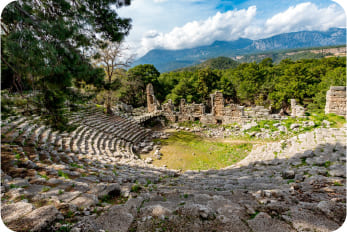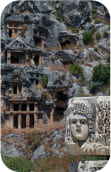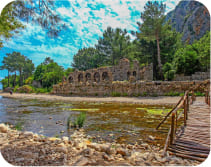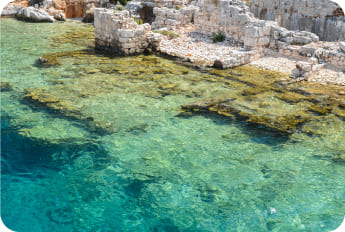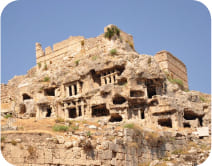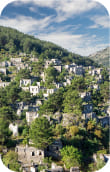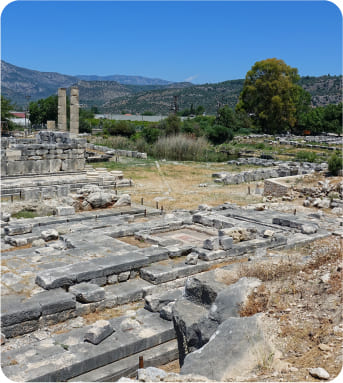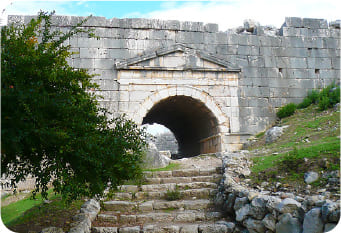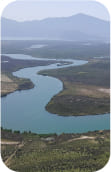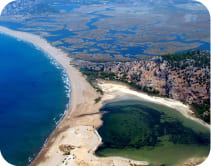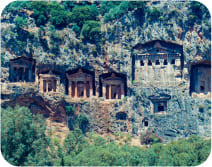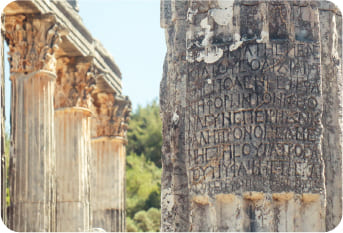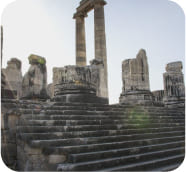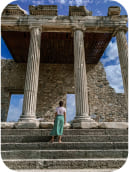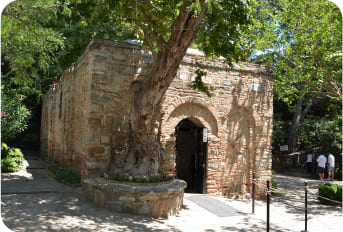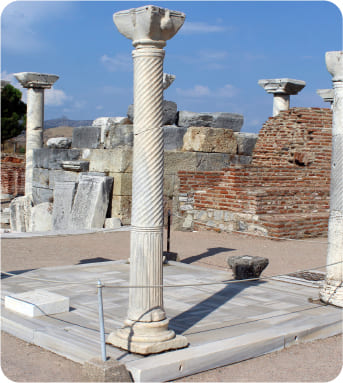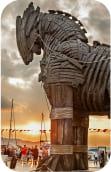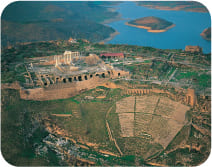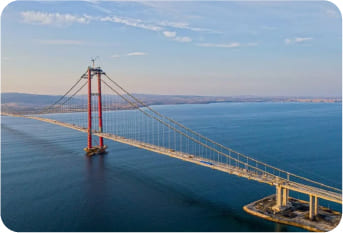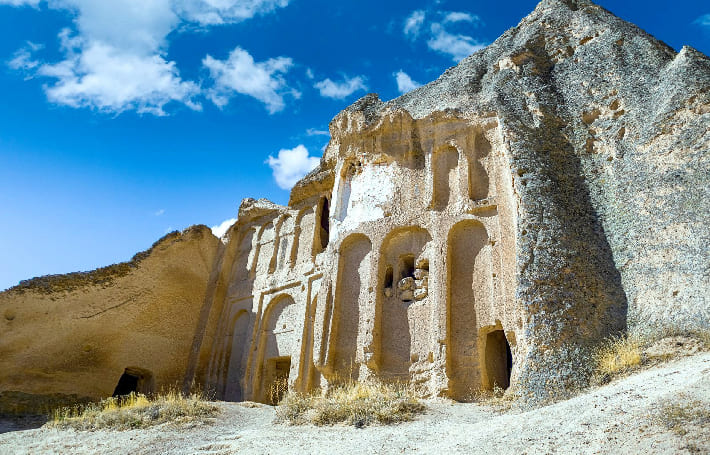



Minimum group size: 4 people

Tour price:
/to be confirmed/
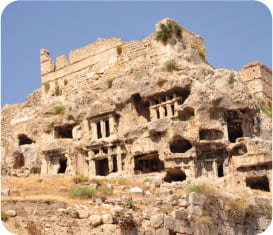
Tlos
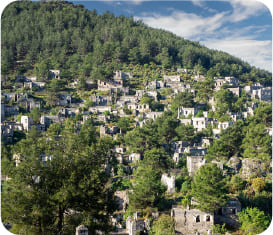
Kayaköy
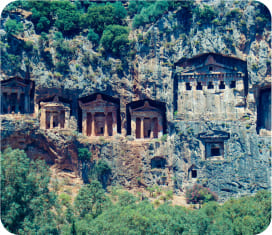
Kaunus
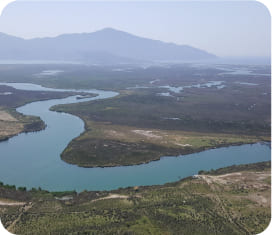
The Dalyan Rive
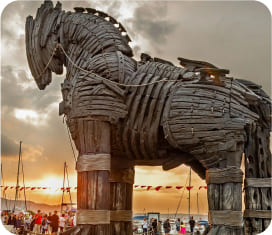
The Trojan Horse
Early departure from Antalya for a tour including visits to Phaselis and Olympos.
Phaselis. An ancient Lycian city that once served as a bustling pirate harbor. Today, only ruins remain as a testament to its past. The pine trees in the area fill the air with an invigorating fragrance that’s simply unforgettable.
Olympos. Like Phaselis, Olympos was also a city frequented by pirates. Nearby is the famous flaming mountain, Chimera, a natural wonder.
Overnight stay at a hotel in Kemer.
Demre and Myra. On this day, we invite our guests to explore the ancient city of Myra, now located on the outskirts of the charming Mediterranean town of Demre. Following in the footsteps of the Apostle Paul, who once disembarked at this harbor to preach Christianity and prepare for his journey to Rome, we will walk the grounds of ancient Myra.
Interestingly, Demre is also the hometown of Santa Claus, or more accurately, his prototype, Saint Nicholas of Patara. We will visit the Church of St. Nicholas the Wonderworker in the heart of the city, where visitors can make a wish, said to surely come true.
Kekova. Next, participants will enjoy a boat trip in the crystal-clear sea surrounding Kekova, offering a chance to relax and marvel at the beauty of the island. Beneath the gentle waves, one can see the ruins of the ancient cities of Kekova and Simena, submerged after an earthquake.
The boat tour concludes at the harbor of the resort town of Kaş, where the group will spend the night at a local hotel.
This day offers guests an eventful itinerary, including visits to several remarkable landmarks.
Xanthos (Xanthos). On these ruins, you’ll find the world's longest inscription in the Lycian language and cliff tombs with bas-reliefs on their columns. A special bonus: the chance to explore inside the tombs, something not allowed in Demre or Fethiye.
Tlos. Known for its cliffside tombs and stunning views, Tlos was once one of the most important Lycian cities, with a history dating back long before Lycia, to the 20th century BCE.
Here, we’ll explore rock-cut tombs, search for the legendary tomb of Bellerophon (mentioned in Homer’s Iliad), and take memorable photos of the surrounding mountains and the Xanthos Valley.
The Ghost Town of Kayaköy. Only a century ago, Kayaköy was a thriving, bustling town with 1,000 homes, several churches, windmills, monasteries, and schools. It housed one of Turkey’s largest Greek communities for centuries, but during the 1920s, the country forced out non-Turkish populations. The Greeks returned to their homeland, and the Turks didn’t repopulate the area, as they were unaccustomed to mountain living. A series of earthquakes 30 years later left Kayaköy in ruins.
Located in the Levissi Valley, Kayaköy is surrounded by tombs from the 4th century BCE and Lycian-era monuments. The town itself was built without a formal plan, using stones, sand, and materials from older structures. Most homes had two rooms, fireplaces, toilets, and cisterns for collecting rainwater, all of which can still be seen today.
Letoon. An ancient city once part of the Lycian League, Letoon’s ruins are found in the village of Kumluova, in the Xanthos Valley.
The city’s name comes from the goddess Leto, the mother of Apollo and his sister Artemis. The three temples unearthed here are dedicated to these deities of the Greek pantheon.
Letoon wasn’t an ordinary settlement; it was surrounded by smaller villages and served as a sort of "conference palace". It thrived in this capacity until the 7th century CE, after which it was abandoned and forgotten for centuries.
At the center of Letoon stands the Temple of Leto, flanked by two smaller temples dedicated to Apollo and Artemis. The Temple of Leto is the best-preserved structure, believed by archaeologists to have been built during the reign of Roman Emperor Hadrian, based on an older temple that was renovated. The Temple of Artemis is the oldest in Letoon, while the Temple of Apollo features beautiful mosaics in its center.
Overnight stay at a hotel in Fethiye.
Transfer to Bodrum (220 kilometers).
Today, our guests will explore pristine Turkey, starting with a journey along the Dalyan River. Guests will enjoy a boat ride, visit thermal springs, and photograph ancient Lycian tombs carved directly into the cliffs. If luck is on their side, they might spot the Caretta-Caretta turtles swimming in the river. The day also includes a visit to the ancient city of Kaunos, where guests can sit at the edge of a 20,000-seat ancient amphitheater and whisper to friends standing on stage.
Sultaniye Thermal Springs. The Dalyan area is renowned for its thermal water sources, which have attracted visitors since ancient times. According to legend, even Aphrodite, the goddess of love, bathed in these rejuvenating waters. The ancient Greeks and Romans established healing centers here, near the city of Kaunos, to benefit from the mineral-rich waters and therapeutic mud. Guests can opt for a mud bath experience for an additional fee.
Lycian Tombs and the Ancient City of Kaunos (Kaunus). In ancient times, the site where Dalyan now stands was submerged beneath a strait connecting the Aegean Sea to what is now Lake Köyceğiz. Over time, a series of powerful earthquakes raised the seabed, forming the sandy İztuzu Beach, which eventually cut off the gulf from the sea and transformed it into a freshwater lake.
The city of Kaunos, named after its legendary founder, was established on the shores of this strait. According to Greek mythology, Kaunos fled to this area due to a troubled relationship with his sister, Byblis. Early inhabitants of Kaunos were not Greeks but Lycians, who left behind the iconic monumental tombs carved into the cliffs overlooking the river.
Over time, Kaunos evolved into a typical ancient Greek city with an agora (marketplace and gathering spot), an amphitheater, a palestra, and a harbor fortified with the Heracleion fortress. After the Roman conquest, new temples and public baths were constructed, the amphitheater was expanded, and a fountain was added to the agora. During the 4th century, following the Christianization of the region, a grand basilica was built, whose ruins remain visible today.
In 625 CE, Kaunos was sacked by the Arabs and began to decline. Earthquakes and the retreating sea transformed its once-thriving harbor into a swamp teeming with turtles.
Overnight stay at a hotel in Bodrum.
Transfer from Bodrum to Kuşadası (155 km). Today, we will explore the ancient cities of Ionia, visit the giant stone eyes of the Gorgon Medusa in Didyma, and much more. Despite the historical richness, these Turkish cities are vibrant and modern, making the experience far from overwhelming.
Bodrum. We will stroll through the streets of the famous Turkish resort of Bodrum, which was built on the site of the legendary ancient Halicarnassus, a city contemporary to the Trojan War. Our guests will see the Castle of Halicarnassus, the ruins of one of the "Seven Wonders of the Ancient World", the Mausoleum, as well as the Castle of Saint Peter (now an archaeological museum), once home to the Knights Hospitaller.
Euromos. An ancient city that boasts a well-preserved temple. Of the 32 graceful columns, 16 stand tall and steady, resembling a beautiful illustration from a history textbook.
Didyma. In Didyma, you’ll feel like a little person. The giant columns and the size of the Temple of Apollo here are truly astonishing. This temple was the largest in Ionia, although its construction was never completed. It was also famous for its oracle, which rivaled that of Delphi.
Miletus. The pearl of Ionia. A once great and renowned city, described by Herodotus. Miletus was famous for its philosophical school, being the birthplace of thinkers like Thales, Anaximenes, and Anaximander. However, the city’s golden age ended in decline, caused by wars with Persia and the silting up of the river that connected the city to the sea. By the 15th century, Miletus was abandoned.
Overnight stay at a hotel in Kuşadası.
Ephesus, the largest ancient city on the Aegean coast, was one of the key centers of early Christianity. This city housed the Temple of Artemis, one of the "Seven Wonders of the Ancient World." Ephesus is also renowned as the final dwelling place of the Virgin Mary and the Apostle John. The city's grandeur is evident in its sculptures, ancient temples, the awe-inspiring Great Theater, and the renowned Library of Celsus.
The House of the Virgin Mary. After Christ's crucifixion, the Virgin Mary is believed to have preached in Asia Minor and spent her final years near Ephesus, hiding from Roman authorities. Although no documentary evidence exists, the Third Ecumenical Council confirmed the tradition that Mary lived here until her death.
The Basilica of Saint John. The Apostle John, who is said to have lived to the age of 100 and was the only disciple of Christ to die a natural death, authored one of the four canonical gospels. We will visit the site believed to be his burial place.
Overnight stay at a hotel in Izmir.
Troy. Located within the village of Tevfikiye, 25 kilometers from Çanakkale, Troy is one of the most renowned cities of the ancient world. It is immortalized in Homer’s epics The Iliad and The Odyssey, which are among the earliest written works of Western literature.
Archaeological excavations in Troy have revealed nine cultural layers, with the earliest dating back to 3000 BCE. From this period, only foundations and fragments of pottery remain.
Some of the most remarkable finds from Troy are dated to 2500–2300 BCE, including the famous "Priam's Treasure," named after the legendary Trojan king. This collection consists of over 10,000 items, including gold beads, earrings, bracelets, diadems, and a golden forehead band. The treasure is currently housed in the Pushkin State Museum of Fine Arts in Russia. Since 1998, the ruins of Troy have been recognized as a UNESCO World Heritage Site.
Troy Archaeological Museum. This museum, located near the excavation site, opened in 2018. It offers visitors a glimpse of historical artifacts from Troy and other ancient cities. Visiting the museum is optional and requires an additional fee.
The Acropolis of Pergamon. Pergamon is famous for its magnificent altar, known as the Great Altar of Pergamon. During the Attalid dynasty, Pergamon hosted the second-largest library of the ancient world, surpassed only by the Library of Alexandria, with hundreds of thousands of scrolls. Visitors may also opt to explore the Asclepion, an ancient medical center, for an additional fee.
Overnight stay at a hotel in Çanakkale.
On this day, we will visit the following highlights:
The Çanakkale Martyrs' Memorial. It commemorates the 250,000 Turkish soldiers who lost their lives during the Gallipoli Campaign in World War I. This significant landmark serves as a poignant reminder of the bravery and sacrifice of those who fought in one of the most pivotal battles in Turkish history.
The 1915 Çanakkale Bridge. Also known as the Dardanelles Bridge, this is an extraordinary modern feat of engineering. It is a suspension bridge with a total length of 3,563 meters (4,608 meters including approach viaducts). The main span measures 2,023 meters, while the height of its two towers reaches 318 meters (334 meters including the tower's top railings). It is a marvel of architectural ingenuity and an iconic landmark connecting Europe and Asia.
The Trojan Horse from the Film "Troy". This replica of the Trojan Horse was created for the 2004 Hollywood movie Troy. Made from steel beams and fiberglass, it stands over 11 meters tall and weighs 11 tons. The horse was designed to be dismantled for transportation and has traveled to various locations around the world before finding its permanent home in Turkey. Today, it is a beloved attraction for visitors and a symbol of Troy’s enduring legend.
On this day, we will travel to Istanbul, concluding our main itinerary.
Guests may depart for their home countries from Istanbul. For those wishing to explore further, the tour can continue with the "Magnificent Istanbul" program, which spans 4 days and 3 nights.
